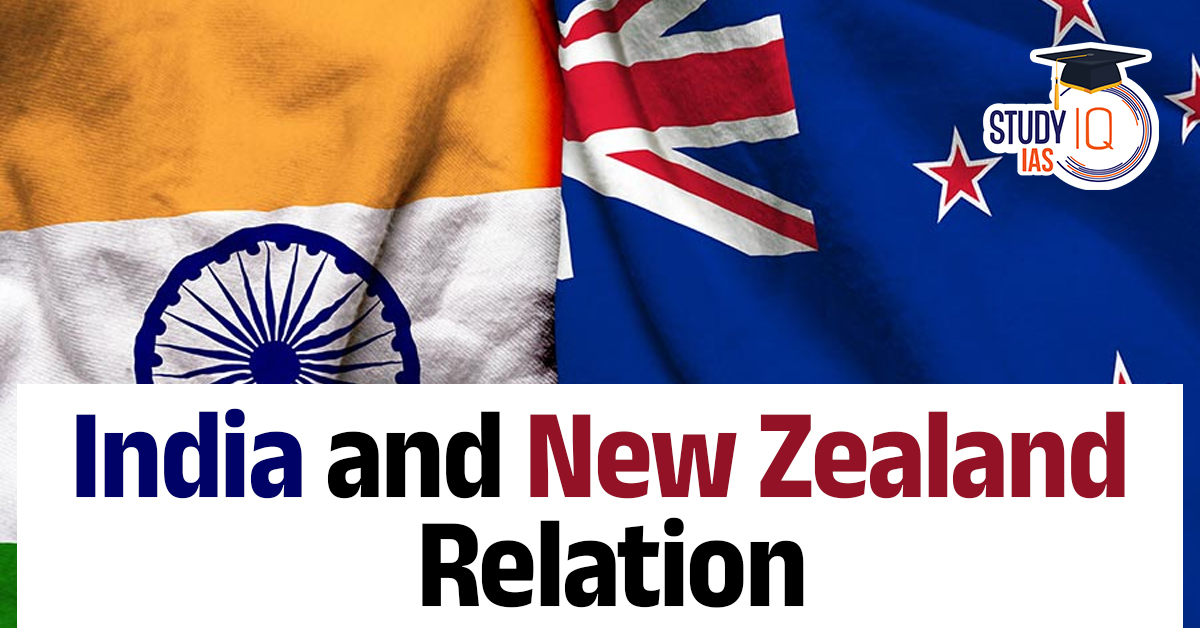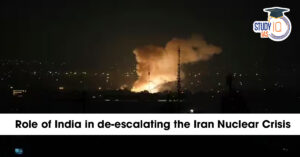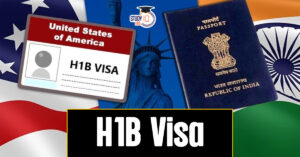Table of Contents
Context: Prime Minister of New Zealand, Rt Hon Christopher Luxon, is on an official visit to India.
India and New Zealand Relation: Areas of Cooperation
Check here all aspects of India and New Zealand Relation in different areas:
Historical Relation
- Early Indian Migration: Indians began arriving in New Zealand in the late 18th century on British East India Company ships.
- Early migrants were primarily from Gujarat and later from Punjab.
- Formation of the Auckland Indian Association in 1920 (centenary celebrated in 2020).
- Diplomatic Relations: Both countries became independent in 1947.
- India established diplomatic representation in 1950 with a Trade Commission, later upgraded to a High Commission.
- Shared Similarities:
- Commonwealth membership.
- Common law practices.
- Democratic governance focused on diverse communities.
Political, Defence, and Security Cooperation
- Parliamentary Engagement: Regular parliamentary delegation visits.
- Defence Collaboration: Increased participation in military exercises and staff college exchanges.
- Regular port calls by naval ships (e.g., Tarini at Lyttelton and HMNZS Te Kaha at Mumbai).
- The signing of the India-New Zealand MoU for Defence Cooperation to establish regular bilateral defence engagement.
- Maritime Security: India’s participation in Combined Maritime Forces and cooperation under Command Task Force 150.
- New Zealand’s interest in joining the Indo-Pacific Oceans Initiative (IPOI).
- Discussions on maritime cooperation at the National Maritime Heritage Complex (NMHC) at Lothal.
- Capacity Building: Regular officer training exchanges at Defence Colleges.
Trade, Investment, and Financial Cooperation
- Trade: Current bilateral trade at US$2.83 billion indicates significant untapped potential.
- FTA Negotiations: Agreement to launch negotiations for a balanced, comprehensive trade agreement.
- Digital Payments: Discussions on early cooperation in the digital payments sector.
- Customs Cooperation: Signing of the Authorized Economic Operators Mutual Recognition Arrangement (AEO-MRA) under the Customs Cooperation Arrangement (CCA) (2024).
- AEO-MRA facilitates smoother trade by easing the movement of goods between trusted traders.
- Sectoral Cooperation in Horticulture and Forestry: Memorandum of Cooperation on Horticulture to promote knowledge sharing and research exchanges.
- Development of post-harvest and marketing infrastructure.
- Letter of Intent on Forestry Cooperation for policy dialogues and technical exchanges.
- Tourism and Air Connectivity: Recognition of tourism’s role in enhancing economic ties and mutual understanding.
- Update to the India-New Zealand Air Services Agreement to support direct flights.
- Encouragement for airlines to commence non-stop flights between India and New Zealand.
Science, Technology, and Disaster Management
- Technology Partnerships: Strengthening collaboration in research, innovation, and commercialization of technologies.
- Climate Change Cooperation: New Zealand’s membership in the International Solar Alliance (ISA) (since 2024).
- New Zealand’s membership in the Coalition for Disaster Resilient Infrastructure (CDRI).
- Earthquake Mitigation: Work towards a MoU on Earthquake Mitigation to enhance preparedness and response capacity.
Education, Mobility, and People-to-People Ties
- Education: Signing of a refreshed Education Cooperation Arrangement.
- Expansion of Indian student access to New Zealand education institutions.
- Skilled Migration: Agreement to negotiate skilled worker mobility under a trade agreement.
- Addressing irregular migration issues.
- Sports: MoU on Sports Cooperation in cricket, hockey, and Olympic sports.
- Sporting Unity events in 2026 to celebrate 100 years of sporting ties.
- Traditional Medicine: Expert discussions on knowledge exchange and collaboration.
- Cultural Ties: Growing New Zealand interest in yoga, Indian music, dance, and festivals.
- Promotion of bilateral cultural exchange.
What are the Challenges between India and New Zealand Relation?
- Trade Negotiation Barriers: FTA negotiations, initiated in 2009, face delays due to India’s protectionist policies.
- High tariffs on agriculture and dairy products remain a sticking point.
- India’s focus on domestic food security complicates trade liberalization.
- Eg., New Zealand, a major exporter of dairy products, has been keen to access the Indian market for selling milk powder and dairy products.
- However, India has opposed this due to concerns within its domestic dairy industry.
- China’s Growing Influence: China’s strategic agreements in the Pacific (e.g., with the Cook Islands) create pressure on New Zealand.
- New Zealand’s economic reliance on China complicates its foreign policy balancing act.
- Geopolitical Differences: Historical differences over India’s nuclear policies have strained ties in the past (e.g., New Zealand’s opposition to India’s nuclear tests (1998)).
- New Zealand’s traditionally cautious approach to security alliances creates hesitation in deeper strategic engagement.
- Political Sensitivities: Concerns over India’s domestic political and human rights issues could limit diplomatic engagement.
- Differences in political systems and governance styles create friction in policy alignment.
- Regulatory and Logistical Barriers: Differences in regulatory standards and customs procedures hinder smooth trade.
- Complex visa processes and work permits limit mobility for professionals and students.
- Economic Asymmetry: India’s large and diverse economy contrasts with New Zealand’s smaller, export-dependent market.
- Finding mutually beneficial trade terms is challenging due to this economic imbalance.
Way Forward
- Revive and Conclude FTA Negotiations: Address India’s protectionist concerns through phased tariff reduction on sensitive products.
- Explore sector-specific trade agreements in non-sensitive areas like technology and services.
- Enhance Strategic Cooperation in the Indo-Pacific: Develop joint maritime security initiatives to counter China’s assertiveness.
- Align with regional frameworks like the Quad and the Pacific Island Forum for greater security cooperation.
- Expand Economic and Trade Ties: Diversify trade beyond agriculture and dairy, focusing on technology, pharmaceuticals, and renewable energy.
- Encourage business-to-business partnerships and investment forums.
- Boost Educational and Cultural Exchange: Establish joint research programs in climate change, clean energy, and the blue economy.
- Simplify visa procedures to enhance student and professional mobility.
- Strengthen Collaboration on Climate Change and Sustainability: Partner on clean energy initiatives and sustainable development projects in the Pacific.
- Support climate resilience and disaster management efforts in small island nations.
- Leverage Diaspora and Soft Power: Engage the Indian diaspora in New Zealand as a bridge for stronger economic and cultural ties.
- Promote Indian cultural festivals and New Zealand’s indigenous Maori heritage for mutual understanding.


 Iran Nuclear Crisis and India’s Role f...
Iran Nuclear Crisis and India’s Role f...
 H1B Visa Program, Beneficiaries, Eligibi...
H1B Visa Program, Beneficiaries, Eligibi...
 Comparison Between India & France's ...
Comparison Between India & France's ...

























